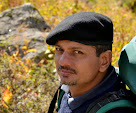 July is a hot month in Delhi. And if your dreams are made of mountains, it can become unbearable in the night. I barely winked the night before I was scheduled to leave for the snow-laden Kedarnath. I tosssed and turned, checked out the clock several times and tried to keep my eyes closed. The wait was over when the clock finally struck 4 and Dr Naren (a medical practitioner and not a PhD scholar by degree) confirmed his arrival. I leapt out of bed and in no time positioned myself behind the wheels of a trusted X-ing for the pilgrim. Less than 14 hours later, with a brief stopover at Rishikesh to pick up a tent, Doc and I touched Gaurikund — a hot-water spring from where the way to Kedarnath shrine begins on foot.
July is a hot month in Delhi. And if your dreams are made of mountains, it can become unbearable in the night. I barely winked the night before I was scheduled to leave for the snow-laden Kedarnath. I tosssed and turned, checked out the clock several times and tried to keep my eyes closed. The wait was over when the clock finally struck 4 and Dr Naren (a medical practitioner and not a PhD scholar by degree) confirmed his arrival. I leapt out of bed and in no time positioned myself behind the wheels of a trusted X-ing for the pilgrim. Less than 14 hours later, with a brief stopover at Rishikesh to pick up a tent, Doc and I touched Gaurikund — a hot-water spring from where the way to Kedarnath shrine begins on foot.Bad news came first. The pilgrim route, still under snow, had not yet been opene
Doc and I raised a toast. Two small glasses full of dark rum clinked in
 the quiet of a darker night. Few men can have a sleepless night, after 14-hour journey and 160 ml of rum (though I must admit that in younger days I have defied worse conditions). Once the Spartan dinner reached our bellies, the two of us fell like a tree.
the quiet of a darker night. Few men can have a sleepless night, after 14-hour journey and 160 ml of rum (though I must admit that in younger days I have defied worse conditions). Once the Spartan dinner reached our bellies, the two of us fell like a tree.It was freezing cold when we got up, but after a brisk walk to the sulphur spring (called Gauri tapt kund), things brightened up. Nothing can be more refreshing than a morning walk to an adolescent river and even more soothing is to find warm waters to wash away your fatigue.
It is about 14 km of walk, mostly uphill, that takes you to the Hindu shrine. For us, it was a mild trek to tone up our ill-used limbs. And although we didn’t go all the way to the shrine, we enjoyed the stretch which woul
 d be otherwise busied with too many pilgrims, porters, pony-riders, polythenes muck and tea stalls. On the flip side, the patrol party was too quick to keep pace with. We had to request them at regular intervals to go slow so we could revive our breath. Thankfully, in due time, we were back for a late lunch. Fresh lauki ki sabzi, dahi and warm rotis tasted divine. The total bill didn’t cross 50 buck even when our bellies showed a devil’s appetite.
d be otherwise busied with too many pilgrims, porters, pony-riders, polythenes muck and tea stalls. On the flip side, the patrol party was too quick to keep pace with. We had to request them at regular intervals to go slow so we could revive our breath. Thankfully, in due time, we were back for a late lunch. Fresh lauki ki sabzi, dahi and warm rotis tasted divine. The total bill didn’t cross 50 buck even when our bellies showed a devil’s appetite.During the lunch itself, we decided there was little time to rest, for we must reach Ukhimath before night if we were to keep our date with Chandrashila peak the next day. Before one could say scoobydoobydoo… the X-ing was negotiating Himalayan bends once again, to reach KMVN tourist lodge for a cosier night.
(Our date with Chopta, Chandrashila and Deoria Taal will appear in the next post)

No comments:
Post a Comment